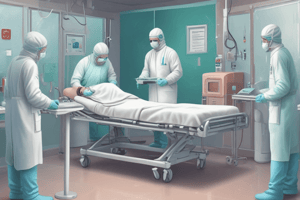Podcast
Questions and Answers
Match the following with their descriptions:
Match the following with their descriptions:
Healthcare Epidemiology = Study of the occurrence, determinants, and distribution of disease within healthcare settings Infection prevention and control (IPC) = Practices and activities aimed at protecting patients, healthcare personnel, and visitors from acquiring infection in healthcare facilities Community-Associated Infections = Infections acquired outside healthcare facilities Iatrogenic Infections = Infections occurring due to medical or surgical intervention
Match the following types of infections with their definitions:
Match the following types of infections with their definitions:
Healthcare-onset infections = Infections appearing in healthcare settings Community-onset infections = Infections appearing outside healthcare settings Healthcare-Associated (Nosocomial) Infections (HAIs) = Infections acquired inside healthcare facilities Urinary tract infections = One of the most common types of nosocomial infections
Match the following with their roles in Healthcare Epidemiology:
Match the following with their roles in Healthcare Epidemiology:
Surveillance measures (statistical studies) = Part of Healthcare Epidemiology covering statistical studies Risk reduction programs focusing on device and procedure management = Part of Healthcare Epidemiology focusing on managing devices and procedures to reduce risk Policy development and implementation = Part of Healthcare Epidemiology involving developing and implementing policies Education of healthcare personnel in infection control practices = Part of Healthcare Epidemiology involving educating healthcare personnel in infection control practices
Match the following with their descriptions:
Match the following with their descriptions:
Match the following with their descriptions:
Match the following with their descriptions:
Match the following nosocomial infection factors with their descriptions:
Match the following nosocomial infection factors with their descriptions:
Match the following Gram-positive cocci with their characteristics:
Match the following Gram-positive cocci with their characteristics:
Match the following Gram-negative bacilli with their characteristics:
Match the following Gram-negative bacilli with their characteristics:
Match the following pathogens with their associated infections:
Match the following pathogens with their associated infections:
Match the following characteristics with the corresponding Enterobacteriaceae pathogens:
Match the following characteristics with the corresponding Enterobacteriaceae pathogens:
Match the following characteristics with the corresponding Pseudomonas aeruginosa pathogens:
Match the following characteristics with the corresponding Pseudomonas aeruginosa pathogens:
Match the following characteristics with the corresponding Clostridium difficile pathogen:
Match the following characteristics with the corresponding Clostridium difficile pathogen:
Match the following characteristics with the corresponding antibiotic-resistant pathogens:
Match the following characteristics with the corresponding antibiotic-resistant pathogens:
Match the following factors contributing to nosocomial infections with their descriptions:
Match the following factors contributing to nosocomial infections with their descriptions:
Match the following Gram-positive cocci with their resistance characteristics:
Match the following Gram-positive cocci with their resistance characteristics:
What is the primary aim of Healthcare Epidemiology?
What is the primary aim of Healthcare Epidemiology?
Which of the following is an example of a healthcare-onset infection?
Which of the following is an example of a healthcare-onset infection?
What are the primary practices and activities covered under Healthcare Epidemiology?
What are the primary practices and activities covered under Healthcare Epidemiology?
Which type of infection occurs due to medical or surgical intervention?
Which type of infection occurs due to medical or surgical intervention?
What are the most common types of nosocomial infections?
What are the most common types of nosocomial infections?
What is the primary focus of risk reduction programs in Healthcare Epidemiology?
What is the primary focus of risk reduction programs in Healthcare Epidemiology?
What does Healthcare-Associated Infections (HAIs) include?
What does Healthcare-Associated Infections (HAIs) include?
What is the main focus of Policy development in Healthcare Epidemiology?
What is the main focus of Policy development in Healthcare Epidemiology?
What are Community-Associated Infections?
What are Community-Associated Infections?
What is the primary focus of Education in Healthcare Epidemiology?
What is the primary focus of Education in Healthcare Epidemiology?
Which type of infections are major factors contributing to nosocomial infections?
Which type of infections are major factors contributing to nosocomial infections?
Which pathogen is a major cause of antibiotic-associated diarrhea (AAD) and pseudomembranous colitis (PMC)?
Which pathogen is a major cause of antibiotic-associated diarrhea (AAD) and pseudomembranous colitis (PMC)?
Which pathogen is commonly found in the environment, causes respiratory tract and bloodstream infections, and is resistant to antibiotics and sterilization techniques?
Which pathogen is commonly found in the environment, causes respiratory tract and bloodstream infections, and is resistant to antibiotics and sterilization techniques?
Which group of pathogens includes Escherichia coli, Klebsiella pneumoniae, and Enterobacter spp. as part of the normal flora in the colon and are associated with intra-abdominal/liver/urinary tract infections?
Which group of pathogens includes Escherichia coli, Klebsiella pneumoniae, and Enterobacter spp. as part of the normal flora in the colon and are associated with intra-abdominal/liver/urinary tract infections?
Which type of pathogens are often differentiated from Staphylococcus aureus by being less pathogenic, more resistant to antibiotics, and found on the skin more?
Which type of pathogens are often differentiated from Staphylococcus aureus by being less pathogenic, more resistant to antibiotics, and found on the skin more?
Which pathogen belongs to the group of Gram-negative Bacilli, is found in the environment, and resists antibiotics and sterilization techniques?
Which pathogen belongs to the group of Gram-negative Bacilli, is found in the environment, and resists antibiotics and sterilization techniques?
Which pathogen is known for its strong adhesion to biomaterial surfaces and is less pathogenic than Staphylococcus aureus?
Which pathogen is known for its strong adhesion to biomaterial surfaces and is less pathogenic than Staphylococcus aureus?
Which bacteria are of major global public health concern and include bacteria producing extended spectrum β-lactamases (ESBLs) as well as carbapenemase-producing Enterobacteriaceae (CPEs)?
Which bacteria are of major global public health concern and include bacteria producing extended spectrum β-lactamases (ESBLs) as well as carbapenemase-producing Enterobacteriaceae (CPEs)?
Flashcards are hidden until you start studying




